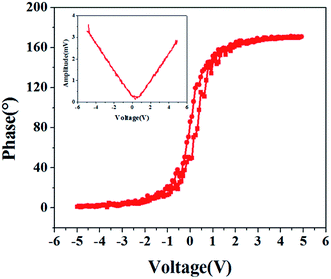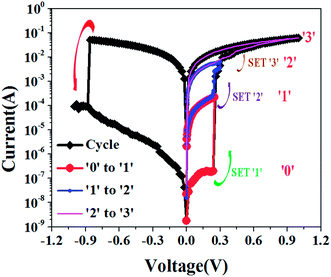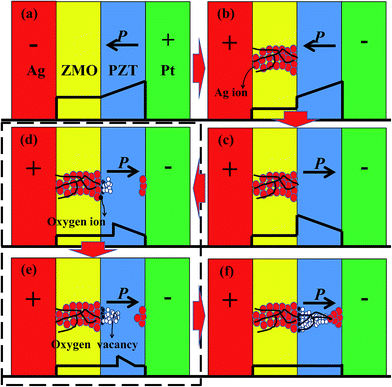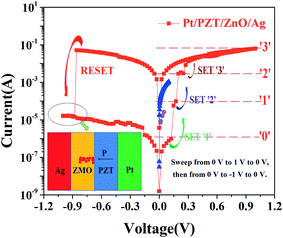Investigation of multilevel data memory using filament and polarization control†
Pengfei Houabc,
Jinbin Wang *abc and
Xiangli Zhong*abc
*abc and
Xiangli Zhong*abc
aSchool of Materials Science and Engineering, Xiangtan University, Hunan, Xiangtan 411105, China. E-mail: jbwang@xtu.edu.cn; xlzhong@xtu.edu.cn; Fax: +86-731-58298119; Tel: +86-731-58293030
bHunan Provincial National Defense Key Laboratory of Key Film Materials & Application for Equipment, Xiangtan University, Hunan, Xiangtan 411105, China
cKey Laboratory of Low-dimensional Materials and Application Technology, Xiangtan University, Hunan, Xiangtan 411105, China
First published on 24th August 2016
Abstract
Multi-state storage memory is a breakthrough for further improving the density in random access memory. However, the low switching ratio and high operating voltage limit the application of multibit-storage. Herein, we report a kind of four state memory with low operating voltage, in which the four states are caused by polarization switching and filament forming/rupture. In the switching of the four states, the electronic transport mechanisms of the device switch between thermionic injection and electron tunneling. Especially, the four states can be written/erased feasibly and distinguished clearly in the reading processes. It shows strong promise for the application of high storage density nonvolatile memory.
1 Introduction
Resistance switching random access memory (RRAM), which is based on resistance change modulated by electrical stimulus, has recently inspired scientific and commercial interest due to its high operation speed, high scalability, and multibit-storage potential.1–4 A variety of new materials and concepts have been explored for resistance switching based memories.3,5–9 These devices reversibly and reproducibly switch between a conducting state (“ON” state or low resistance state, LRS) and an insulating state (“OFF” state or high resistance state, HRS). Reading of the resistance states is nondestructive, and the memory devices can be operated without transistors in every cell, thus making a cross-bar structure feasible.10,11 However, fabrication of 3D cross-bar array with RRAM devices is generally difficult due to so-called “sneak current” problem in the application.12–14 The operating voltages and resistance ratios of RRAM devices are readily adjustable by varying the thickness and composition of the film. But control is one of their important issues, and the multibit-storage in RRAM still needs transistors in every cell. Furthermore the integration of selector devices (such as transistors) is required in a common way.15 So the multibit-storage, which attracts much more scientific and commercial interests, may realize by investigating special concepts based on physical processes.6,16 Typically, two types of resistive switching mechanisms have been proposed, namely, filamentary and homogeneous switching behaviors. But how to control the transformation between filamentary and homogeneous resistive switching only has a few reports.6 Furthermore, the two different resistive switching mechanisms have little potential to be used into multibit-storage in these reports. However, besides ionic motion-based switching, some other kinds resistive switching based on other physical processes, including electronic, magnetic, ferroelectric and microstructural alterations, have been actively investigated.16–18 Combination of these different concepts shows potential to realize multibit-storage.19 People have tried to combine ferroelectric tunnel junctions with ferromagnetic electrodes,19 but the switch ratio and control process are not very suitable to apply these devices into reality. The switch ratio of other existing multi-states devices is low, and the operate voltage of these device is high.20–26 If the concepts which can write and erase in the same ways could be combined together to make a device, the device would not only realize multibit-storage but also feasible write/read. Without a doubt, this kind concept combination would promote the application of multibit-storage. In filamentary resistance switching devices and ferroelectric tunnel junctions (FTJs), the resistance states are all controlled by the external electric field. If they could be assembled together, it would not only realize multibit-storage but also the non-destructive read.5,6,16 Even more the operating voltage would be very low for the use of thin film. Based on the discussion we reported former, the PZT film can be used to make a memory controlled by oxygen vacancies.27 And the leakage current of ultrathin PZT film grown on Pt substrate is not very large, it still can achieve ferroelectricity. The device with ZnO film and Ag electrode can be used to make the filamentary resistance switching device, Mn dopant in ZnO can increase the resistance of ZnO.5 So in this work, we investigate a kind of memory based on PbZr0.52Ti0.48O3 (PZT) ultrathin film and ZnO:Mn (ZMO) thin film as a structure of metal–semiconductor–ferroelectric-metal (MSFM). The resistive switching behaviors, which exhibit a combination of different resistive switching behaviors and memory performances, are investigated in detail. The possible transformation mechanisms are systematically proposed. By controlling SET and RESET voltages, we are able to demonstrate a controllable storage at two high resistance states (HRS1 and HRS2) and two low resistance states (LRS1 and LRS2). Furthermore, the four states can be distinguished clearly in the read processes after written with low operate voltage.2 Experimental section
Sample preparation
PZT films with thickness of 8 nm have been grown by laser molecular beam epitaxy (LMBE, it can exactly control the oxygen pressure above 5 Pa) on Pt-coated silicon. During deposition of the PZT layer, substrate temperature was maintained at 625 °C with chamber oxygen pressure kept at 22 Pa. The samples were cooled down to room temperature in oxygen atmosphere at 22 Pa. ZMO film (2% Mn-doped ZnO) with thickness of 20 nm has been grown by Pulsed Laser Deposition (PLD, it can exactly control the oxygen pressure below 5 Pa) on PZT film. During deposition of the ZMO layer, substrate temperature was maintained at 300 °C with chamber oxygen pressure kept at 20 mTorr. The samples were cooled down to room temperature in oxygen atmosphere at 100 mTorr. Ag dot electrodes were fabricated by d.c. sputtering through a shadow mask about 100 μm in diameter at room temperature.Characterization
The film thicknesses have been measured on Filmetrics model F20-UV and F50-UV. The polarization-voltage measurement characteristics were measured using a Radiant technologies precision workstation ferroelectric test system. The piezoresponse Atom Force Microscopy (AFM) images were performed using the AFM with a conductive AFM tip. The current–voltage (I–V) measurement characteristics have been measured using an Agilent B1500A semiconductor device analyzer. The XRD results have been performed using X-ray diffraction (D/MAX-2500/PC).3 Results and discussion
Fig. 1(a) presents the structure of Ag/ZMO/PZT/Pt. Fig. 1(b) shows the XRD result of Ag/ZMO/PZT/Pt with peaks at the (101) and (113) planes of PZT film, peaks at the (110) and (103) planes of ZMO film. Local PFM phase hysteresis and amplitude loops of 8 nm thick PZT thin film are shown in Fig. 2, all these show that the 8 nm thick PZT thin film has ferroelectricity. | ||
| Fig. 1 (a) Schematic drawing of the Ag/ZMO/PZT/Pt structure. (b) XRD pattern of Ag/ZMO/PZT/Pt device. | ||
I–V characteristics of the Ag/ZMO/PZT/Pt memory cell were studied by dc voltage sweep measurements to evaluate the memory effects of the obtained device, and the results are illustrated in semilogarithmic scales (as shown in Fig. 3). During the measurements, the voltage was swept in a sequence of 0 V → 1 V → 0 V → −1 V → 0 V. By steady increase of the positive voltages imposed on the device, three pronounced changes of resistance from HRS1 (‘0’) to HRS2 (‘1’), HRS2 to LRS1 (‘2’) and LRS1 to LRS2 (‘3’) were observed at about 0.25 V, 0.3 V and 0.7 V, which are called the SET1 process, SET2 process and SET3 process, respectively. Subsequently, an opposite ‘RESET’ process could also be seen when the voltage was swept reversely to negative values about −0.9 V. It is a four states memory, making the periphery circuit very easy to distinguish the storage information (‘0’, ‘1’, ‘2’ and ‘3’). It is worthwhile to point out that the resistive switching behavior of our cell exhibits a typical bipolar nature, that is, the cell can only be written with a positive bias and erased with a negative one as verified by numerous measurements.
As shown in Fig. 3, after the voltage was swept in a sequence of 0 V → 1 V → 0 V → −1 V → 0 V, the memory cell stayed at HRS1. Then the voltage was swept in a sequence of 0 V → 0.25 V → 0 V, the memory cell would turn to HRS2. LRS1 would appear after a voltage sweeping as a sequence of 0 V → 0.3 V → 0 V. At last, LRS2 appeared after a voltage sweeping as a sequence of 0 V → 1 V → 0 V. HRS1, HRS2 and LRS1 can be read from 0 V to 250 mV, from 0 V to 300 mV, and from 0 V to 700 mV, respectively. Obviously, LRS2 can be read from 0 V to 1 V. However, the four states should be read at a constant voltage, which cannot destroy the resistance state in the application. So the read voltage should be under 250 mV.
One important question is the transport mechanism that governs the resistance. As the ZMO film and PZT ferroelectric film are relatively thick (20 nm and 8 nm, respectively), electron tunneling is rather unlikely, when the device is at ‘0’ state. For the investigated barrier thickness, thermionic injection is expected to prevail on the electronic transport at room temperature.28–30 So the resistance R‘0’ = RZMO + RPZTR is high at ‘0’ state (RZMO is the resistance of ZMO film without filament, RPZTR is the resistance of PZT film polarized to Pt). However, in the effect of the electric field, Ag atoms form filament in ZMO layer, and the resistance state of the device turns from ‘0’ state to ‘1’ state (as shown in Fig. 4(a) and (b)), which is the same to the Ag/ZMO/Pt device reported before.5 I–V curve of the Ag/ZMO/Pt device with 20 nm thick ZMO film is shown in the ESI.† It is mediated by electrochemical redox reactions and an Ag bridge forms in the ZMO film. According to the discussions about Ag/ZMO/Pt,5 when a positive voltage is applied to Ag top electrode, oxidation occurs on this electrochemically active material. Therefore Ag+ cations are generated, which could be described as Ag → Ag+ + e−. The mobile Ag+ cations migrate toward Pt electrode through the ZMO layer and are reduced there by electrons flowing from the cathode, i.e., Ag+ + e− → Ag. The successive precipitations of Ag metal atoms at the cathode lead to a growth of the Ag protrusion, which finally reaches the top electrode and forms a highly conductive path in the ON state. In our case, there is a PZT film between ZMO film and Pt electrode. And the coercive voltage (Vc) of the PZT film is about 0.3 V, which means that the ferroelectric polarization direction of PZT film is opposite to the external electric field below 0.25 V. In this case, the Ag ions cannot migrate into the PZT film, because the electric field in the PZT film is opposite to the direction of Ag migration. So below the voltage of 0.25 V, the mobile Ag+ cations migrate toward the interfaces of ZMO film and PZT film through the ZMO layer and are reduced there by electrons flowing from the cathode, i.e., Ag+ + e− → Ag. In this case, ZMO acts as a conductor benefiting from the formed Ag filament (at ‘1’ state and ‘2’ state). And only the PZT film acts as the barrier, electron tunneling is mainly working. According to a model that described the physics of ferroelectric polarization reversal in FTJs,31 the barrier height changes from high conductance state to low conductance state, which cause the difference between ‘1’ state and ‘2’ state. At ‘1’ state, the resistance R‘1’ = RZMOF + RPZTR, (RZMOF is the resistance of ZMO film with Ag filament). When the electric field is enhanced to 0.3 V, the polarization direction of PZT changed, causing the change of PZT barrier height, and the resistance state of the device turns from ‘1’ state to ‘2’ state (as shown in Fig. 4(b) and (c)), the resistance R‘2’ = RZMOF + RPZTL (RPZTL is the resistance of PZT film polarized to ZMO, RZMOF < RZMO, RPZTL < RPZTR). The values of R‘1’ and R‘2’ are not very large, it is because the top electrode is large and the leakage current of 8 nm thick PZT film is also large. As the electric field is enhanced again, much more Ag atoms will be gathered between the interfaces of PZT film and ZMO film, and the gathered Ag atoms will be like a very small Ag electrode upon the PZT film, so it is like a small Ag/PZT/Pt device (I–V curve of Ag/PZT/Pt device with 8 nm thick PZT film is shown in the ESI†). In the effect of the electric field, the Ag atoms in the interfaces between PZT and ZMO layers will absorb the oxygen ions in the PZT layer, and more oxygen vacancies are forming. In the effect of the electric field, it is possible that the Ag atoms may migrate in PZT layer, because the PZT layer is fairly thin (as shown in Fig. 4(d) and (e), the way of some Ag atoms migrating in PZT layer is like the migrating way in the ZMO layer). But the amount of Ag atoms between PZT layer and ZMO layer is smaller compared with the top Ag electrode, so only the Ag atoms migrating in the PZT layer cannot form the conductive path in the PZT layer. Considering the oxygen vacancies forming by the interfaces of PZT and ZMO layers, the oxygen vacancies and the Ag atoms may form a conductive bridge in the PZT film together. It can explain that the resistance state of the device turns from ‘2’ state to ‘3’ state (as shown in Fig. 4(f)). The formation process of conductive filament in the PZT may be similar to the case of Al/ZnO/Pt, in which the conductive filament is also formed by oxygen vacancies and the Ag atoms32 (the conductive filament in PZT layer27 is mostly affected by the oxygen vacancies is proved in the ESI†). At ‘3’ state, the whole device acts like a conductor, thermionic injection prevails on the electronic transport again. But the thermionic injection at this time is so different with that thermionic injection at the ‘0’ state, and the resistance R‘3’ = RZMOF + RPZTF, (RPZTF is the resistance of PZT film with conductive filament, RPZTF < RPZTL). In a word, the height and width of barriers can be mediated by the external electric field through controlling the filament and polarization directions. ‘0’ state has two high barriers, while the others only have a barrier or no barrier (R‘0’ > R‘1’ > R‘2’ > R‘3’), as shown in Fig. 4. The reason why the transformation from ‘3’ state to ‘0’ state by one step at Vset‘3’ is that the voltage of oxygen ions released is much larger than the voltage of oxygen vacancies filament forming, Ag filament rupture voltage and Vc of PZT. At the RESET voltage, the oxygen ions adsorbed by the Ag electrodes are releasing, the filament formed by oxygen vacancies is broken, and the filament formed by Ag is also broken, all these almost happen at the same time, the resistance state turns to ‘0’.
Fig. 5 shows the three SET voltages and one RESET voltage of the Ag/ZMO/PZT/Pt film memory cell after an endurance test of about 30 cycles (the endurance test is shown in Fig. 6(a), more cycles are shown in Fig. S8†). We find that resistive switching is still very stable at each memory state, and the four states could be read at a proper voltage after the bias sweep. ‘0’, ‘1’, ‘2’ and ‘3’ were read from 0 V to 150 mV, from 0 V to 250 mV, from 0 V to 300 mV and from 0 V to 1 V, respectively. After the endurance test, the filament in the ZMO layer is only broken at ‘0’ state (as shown in Fig. 5), while no filament is existed at former ‘0’ state (‘0’ state as shown in Fig. 4(a)). That is the reason why the three SET voltage values are smaller than those in the first sweeping (as shown in Fig. 3). In addition, the only RESET voltage means the device will turn to ‘0’ state. And the RESET process is needed before the write process in the application of the devices. Retention is an important issue for the nonvolatile memory cells. The four states were written as shown in Fig. 3 and read at 50 mV. In 100 s, the four resistance states are stable, as shown in Fig. 6(b). The I‘1’/I‘0’, I‘2’/I‘1’ and I‘3’/I‘2’ are about 1.1 × 105%, 200% and 300%, they can be distinguished in the application, and the ratios are high.20–26 Although the retention of the devices needs a further more investigation, the multibit-storage and low power operation of the devices show great potential in the research of microelectronic device.
4 Summary
In summary, we have fabricated a kind of Ag/ZMO/PZT/Pt film memory, which is based on filament and polarization control. Considering the promising four states, electrical performance, especially the low operate voltage, these results show that the combination of filament and tunneling current has great prospect as the possible resistance switching mechanism for multi-states memory. It shows strong promise for future high storage density nonvolatile memory applications.Acknowledgements
This work was supported by the National Natural Science Foundation of China (No. 61574121, 11372266, 11272274 and 11402222), the Hunan Provincial Natural Science Foundation of China (No. 12JJ1007), the Specialized Research Fund for the Doctoral Program of Higher Education (No. 20114301110004) and the Foundation for the Author of National Excellent Doctoral Dissertation of PR China (201143).References
- G. I. Meijer, Science, 2008, 319, 1625 CrossRef CAS PubMed.
- Y. Dong, G. Yu, M. C. McAlpine, W. Lu and C. M. Lieber, Nano Lett., 2008, 8, 386 CrossRef CAS PubMed.
- W. Lu and C. M. Lieber, Nat. Mater., 2007, 6, 841 CrossRef CAS PubMed.
- A. Beck, J. G. Bednorz, Ch. Gerber, C. Rossel and D. Widmer, Appl. Phys. Lett., 2000, 77, 139 CrossRef CAS.
- Y. C. Yang, F. Pan, Q. Liu, M. Liu and F. Zeng, Nano Lett., 2009, 9, 1636 CrossRef CAS PubMed.
- C. H. Huang, J. S Huang, S. M. Lin, W. Y. Chang, J. H. He and Y. L. Chueh, ACS Nano, 2012, 6, 8407 CrossRef CAS PubMed.
- D.-H. Kwon, K. M. Kim, J. H. Jang, J. M. Jeon, M. H. Lee, G. H. Kim, X.-S. Li, G.-S. Park, B. Lee, S. Han, M. Kim and C. S. Hwang, Nat. Nanotechnol., 2010, 5, 148 CrossRef CAS PubMed.
- H. Shima, F. Takano, H. Akinaga, Y. Tamai, I. H. Inoue and H. Takagi, Appl. Phys. Lett., 2007, 91, 012901 CrossRef.
- H. Shima, N. Zhong and H. Akinaga, Appl. Phys. Lett., 2009, 94, 082905 CrossRef.
- R. Waser and M. Aono, Nat. Mater., 2007, 6, 833 CrossRef CAS PubMed.
- S. Q. Liu, N. J. Wu and A. Ignatiev, Appl. Phys. Lett., 2000, 76, 2749 CrossRef CAS.
- J. Y. Seok, S. J. Song, J. H. Yoon, K. J. Yoon, T. H. Park, D. E. Kwon, H. Lim, G. H. Kim, D. S. Jeong and C. S. Hwang, Adv. Funct. Mater., 2014, 24, 5316 CrossRef CAS.
- G. H. Kim, K. M. Kim, J. Y. Seok, M. H. Lee, S. J. Song and C. S. Hwang, J. Electrochem. Soc., 2010, 157, G211 CrossRef CAS.
- M. Yu, Y. Cai, Z. Wang, Y. Fang, Y. Liu, Z. Yu, Y. Pan, Z. Zhang, J. Tan, X. Yang, M. Li and R. Huang, Sci. Rep., 2016, 6, 21020 CrossRef CAS PubMed.
- W. Y. Park, G. H. Kim, J. Y. Seok, K. M. Kim, S. J. Song, M. H. Lee and C. S. Hwang, Nanotechnology, 2010, 21, 195201 CrossRef PubMed.
- R. K. Vasudevan, A. N. Morozovska, E. A. Eliseev, J. Britson, J.-C. Yang, Y.-H. Chu, P. Maksymovych, L. Q. Chen, V. Nagarajan and S. V. Kalinin, Nano Lett., 2012, 12, 209 CrossRef PubMed.
- Y. M. Huai, AAPPS Bull., 2008, 18, 6 Search PubMed.
- K. Szot, W. Speier, G. Bihlmayer and R. Waser, Nat. Mater., 2006, 5, 312 CrossRef CAS PubMed.
- H. J. Mao, P. X. Miao, J. Z. Cong, C. Song, B. Cui, J. J. Peng, F. Li, G. Y. Wang, Y. G. Zhao, Y. Sun, L. R. Xiao and F. Pan, J. Appl. Phys., 2014, 116, 053703 CrossRef.
- J. Seidel, L. W. Martin, Q. He, Q. Zhan, Y. H. Chu, A. Rother, M. E. Hawkridge, P. Maksymovych, P. Yu, M. Gajek, N. Balke, S. V. Kalinin, S. Gemming, F. Wang, G. Catalan, J. F. Scott, N. A. Spaldin, J. Orenstein and R. Rames, Nat. Mater., 2009, 8, 229 CrossRef CAS PubMed.
- D. Lee, S. M. Yang, T. H. Kim, B. C. Jeon, Y. S. Kim, J. G. Yoon, H. N. Lee, S. H. Baek, C. B. Eom and T. W. Noh, Adv. Mater., 2012, 24, 402 CrossRef CAS PubMed.
- E. A. Eliseev, A. N. Morozovska, G. S. Svechnikov, V. Gopalan and V. Y. Shur, Phys. Rev. B: Condens. Matter Mater. Phys., 2011, 83, 235313 CrossRef.
- R. K. Vasudevan, et al., Nano Lett., 2012, 12, 209 CrossRef PubMed.
- A. Chanthbouala, A. Crassous, V. Garcia, K. Bouzehouane, S. Fusil, X. Moya, J. Allibe, B. Dlubak, J. Grollier, S. Xavier, C. Deranlot, A. Moshar, R. Proksch, N. D. Mathur, M. Bibes and A. Barthélémy, Nat. Nanotechnol., 2012, 7, 101 CrossRef CAS PubMed.
- M. Gajek, M. Bibes, S. Fusil, K. Bouzehouane, J. Fontcuberta, A. Barthélémy and A. Fert, Nat. Mater., 2007, 6, 296 CrossRef CAS PubMed.
- J. F. Scott, Nat. Mater., 2007, 6, 256 CrossRef CAS PubMed.
- P. Hou, J. Wang, X. Zhong and Y. Wu, RSC Adv., 2016, 6, 54113–54118 RSC.
- D. Pantel and M. Alexe, Phys. Rev. B: Condens. Matter Mater. Phys., 2010, 82, 134105 CrossRef.
- D. Pantel, S. Goetze, D. Hesse and M. Alexe, ACS Nano, 2011, 5, 6032–6038 CrossRef CAS PubMed.
- L. Pintilie, I. Vrejoiu, D. Hesse, G. LeRhun and M. Alexe, Phys. Rev. B: Condens. Matter Mater. Phys., 2007, 75, 104103 CrossRef.
- A. Gruverman, D. Wu, H. Lu, Y. Wang, H. W. Jang, C. M. Folkman, M. Y. Zhuravlev, D. Felker, M. Rzchowski, C. B. Eom and E. Y. Tsymbal, Nano Lett., 2009, 9, 3539–3543 CrossRef CAS PubMed.
- Z. Q. Wang, H. Y. Xu, L. Zhang, X. H. Li, J. G. Ma, X. T. Zhang and Y. C. Liu, Nanoscale, 2013, 5, 4490–4494 RSC.
Footnote |
| † Electronic supplementary information (ESI) available. See DOI: 10.1039/c6ra14324e |
| This journal is © The Royal Society of Chemistry 2016 |





